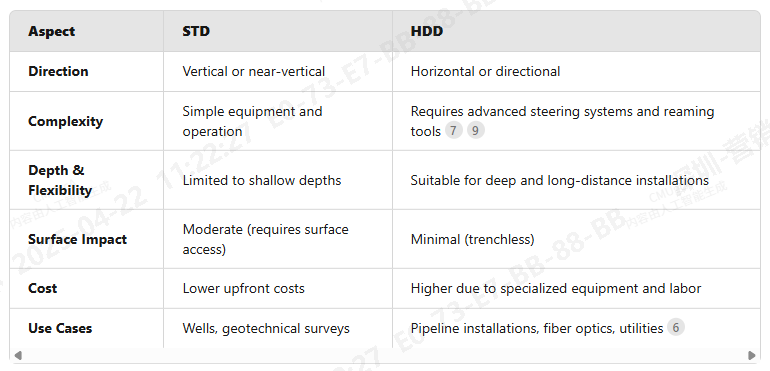What Is the STD Method of Drilling? The Straight Through Drilling (STD) method refers to a conventional vertical drilling technique where a borehole is created perpendicular to the ground surface. This method is typically used in shallow-depth applications, such as constructing water wells, geothermal systems, or foundational pilings.
1. Key characteristics include:
① Process: A drill bit is rotated vertically into the ground, often using rotary or percussion mechanisms. Casing may be installed simultaneously to stabilize the borehole.
② Applications: Suitable for projects requiring straightforward, linear drilling paths with minimal deviation, such as residential well drilling or soil sampling.
③ Advantages: Simplicity, lower equipment costs, and faster completion for shallow depths.
2. HDD (Horizontal Directional Drilling) Method
Horizontal Directional Drilling (HDD) is a trenchless technology designed to install pipelines, cables, or conduits underground along a curved, non-vertical path. It involves three stages: pilot hole drilling, reaming, and product pullback. Key aspects include:
① Process: A steerable drill head creates a pilot hole, which is then enlarged using a reamer. The final pipeline is pulled through the pre-drilled path.
② Applications: Ideal for crossing obstacles like rivers, roads, or urban infrastructure without surface disruption.
③ Advantages: Minimal environmental impact, ability to navigate complex terrains, and reduced restoration costs.
3. Key Differences Between STD and HDD

4. Technical and Operational Contrasts
① Drilling Fluids: STD often uses basic mud systems, while HDD relies on engineered fluids to stabilize boreholes and remove cuttings during reaming.
② Precision: HDD requires real-time monitoring tools (e.g., GPS or gyroscopic sensors) to maintain trajectory accuracy, whereas STD focuses on vertical alignment.
③ Risk Management: HDD mitigates risks like fluid loss in permeable formations through advanced sealing techniques, a challenge less common in STD.
While STD remains a cost-effective solution for straightforward vertical drilling, HDD excels in scenarios demanding minimal surface disruption and complex path navigation. The choice between the two depends on project depth, terrain, environmental constraints, and budget. For instance, urban utility projects increasingly favor HDD, while rural water extraction often relies on STD for simplicity. Both methods highlight the diversity of modern drilling technologies tailored to specific engineering needs.




